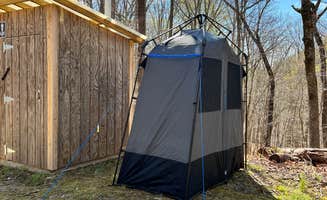Dispersed camping near Percy, Illinois offers a mix of primitive and backcountry experiences within the Shawnee National Forest region. The area sits along the Mississippi River watershed, with elevations ranging from 400-800 feet and a humid continental climate. Spring and fall camping offer moderate temperatures between 45-75°F, while summer brings higher humidity with occasional thunderstorms.
What to do
Explore limestone formations: The Panther Den Wilderness area contains a network of sandstone canyons and rock formations accessible via unmarked hiking trails. These geological features provide natural shelter during inclement weather.
Wildlife observation: Trail of Tears State Forest hosts diverse wildlife including white-tailed deer, wild turkey, and migratory birds. "Remote and rugged" describes the experience at Trail of Tears State Forest, where campers report "excellent for tent camping when you want relatively easy access and still feel a bit of solitude."
Seasonal mushroom hunting: Spring brings morel mushroom hunting opportunities throughout the region, particularly after rainfall when forest floors yield edible fungi. Local regulations permit collection for personal use.
What campers like
Privacy between sites: At Panther Den Wilderness, the dispersed camping allows complete solitude with no designated sites or neighbors. This primitive wilderness experience appeals to those seeking true backcountry camping without facilities.
Cost-effective options: Trail of Tears State Forest provides an economical camping option at $8 per night. One camper noted it was "not free but worth the $8/night" with amenities that exceeded expectations for the price point.
Accessibility to supplies: Despite the rustic setting, campers appreciate the proximity to necessities. Trail of Tears offers reasonable access to towns for resupply, with Anna just 15 minutes away for groceries and basic supplies.
What you should know
Water availability concerns: Trail of Tears State Forest occasionally issues boil water advisories for their potable water sources. A recent camper mentioned "potable water and camper registration (but had a boil water warning but that was not normal)." Carrying water treatment supplies or extra containers is advisable.
Limited cell service: Most dispersed camping areas near Percy have spotty or non-existent cell phone reception, particularly in canyon areas and dense forest. Download offline maps before arrival.
Seasonal considerations: Spring camping brings muddy conditions after rainfall, making some access roads temporarily challenging. Fall offers cooler temperatures and fewer insects, making it preferred for primitive camping.
Tips for camping with families
Bathroom availability: For families with younger children, Trail of Tears State Forest provides basic facilities that make rustic camping more manageable. A camper mentioned they were "surprised to find nice porta potty at our site that was remote from others," which can be crucial for family camping comfort.
Site selection strategy: Families should arrive early to secure sites with level tent pads and natural wind protection. Sites near but not directly adjacent to water sources provide convenience while minimizing insects.
Wildlife awareness: Teach children proper food storage protocols as raccoons and opossums frequently investigate campsites after dark. Use rope systems to hang food at least 10 feet off the ground when camping in more remote areas.
Tips from RVers
Access limitations: Most dispersed camping near Percy has significant limitations for RVs. While Trail of Tears advertises as "big-rig-friendly," actual conditions vary seasonally, with forest roads often unsuitable for larger vehicles after rainfall.
Leveling challenges: RV campers report needing substantial leveling blocks at most primitive sites. Bring twice the normal amount of leveling equipment for rustic camping near Percy, Illinois.
Self-contained requirements: No hookups or dump stations exist at dispersed sites, requiring RVers to be fully self-contained. Plan for 2-3 days maximum stay based on typical holding tank capacities and limited water availability.


